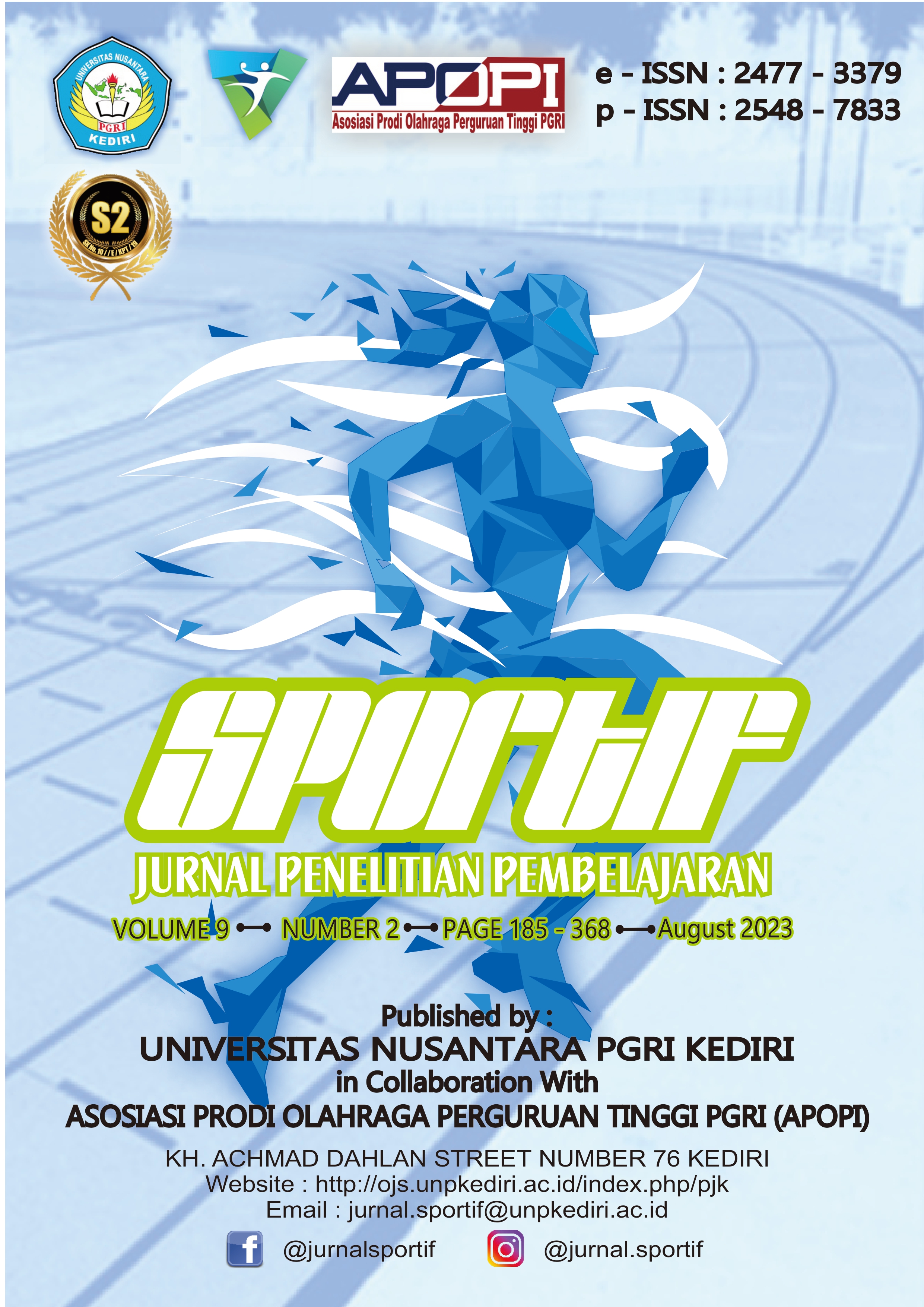Abstract
The importance of physical fitness as one of the supporting factors for student activities needs to be considered. Importance of physical fitness requires improvement and defense in its condition. Providing physical activity is one of the factors that can improve students' physical fitness. This study aimed to determine the effect of low-impact aerobic gymnastics on improving student fitness. This research method uses a pre-experimental design using one group pretest-posttest without using variable control. The study subjects used the Proportionate stratified random sampling technique by taking male students aged 13-15 in junior high school. The research instrument uses the Indonesian Physical Fitness Test to measure strength, speed, endurance, strength, and power. Data analysis techniques use normality and homogeneity prerequisite tests, and to determine the influence on variables using t-tests, data analysis procedures use SPSS 25. The results of the study said The results of calculations using the t-test approach method obtained 0.841. This result is greater than Ttabel, which amounted to 1,701 because the analysis results said there was a significant effect of low-impact aerobic exercise on physical fitness. This study concludes that low-impact aerobic exercise can improve students' physical fitness.
References
Allsabah, M. A. H., Sugito., & Kurniawan, B. T. (2022). Level of physical activity, body mass index ( BMI ), and sleep patterns among school students. Journal Sport Area, 7(1), 134–147. https://doi.org/https://doi.org/10.25299/sportarea.2022.vol7(1).8188
Amatriain-Fernández, S., Murillo-Rodríguez, E. S., Gronwald, T., Machado, S., & Budde, H. (2020). Benefits of physical activity and physical exercise in the time of pandemic. Psychological Trauma: Theory, Research, Practice, and Policy, 12. https://doi.org/10.1037/tra0000643
Arghaya Mondal, A. S. (2015). Comparative Study on Selected Physical Fitness Components among thenPhysical Education Students of Different Universities in West Bengal Staten. IOSR Journal of Sports and Physical Education (IOSR-JSPE), 2(1).
Chen, W., Hammond-Bennett, A., Hypnar, A., & Mason, S. (2018). Health-related physical fitness and physical activity in elementary school students. BMC Public Health, 18(1). https://doi.org/10.1186/s12889-018-5107-4
Coledam, D. H. C., & Ferraiol, P. F. (2017). Engagement in physical education classes and health among young people: Does sports practice matter? A cross-sectional study. Sao Paulo Medical Journal, 135(6). https://doi.org/10.1590/1516-3180.2017.0111260617
Dewi, R., & Rifki, M. (2020). Pengaruh Senam Aerobik Terhadap Tingkat Kebugaran Jasmani Siswa. Jurnal Stamina, 3(6).
Fonseca, A. P. L. M., de Azevedo, C. V. M., & Santos, R. M. R. (2021). Sleep and health-related physical fitness in children and adolescents: a systematic review. In Sleep Science (Vol. 14, Issue 4). https://doi.org/10.5935/1984-0063.20200125
Greier, K., Drenowatz, C., Ruedl, G., Kopp, M., Burtscher, M., & Greier, C. (2020). Effect of Daily Physical Education on Physical Fitness in Elementary School Children. Advances in Physical Education, 10(02). https://doi.org/10.4236/ape.2020.102009
Herbert, C., Meixner, F., Wiebking, C., & Gilg, V. (2020). Regular Physical Activity, Short-Term Exercise, Mental Health, and Well-Being Among University Students: The Results of an Online and a Laboratory Study. Frontiers in Psychology, 11. https://doi.org/10.3389/fpsyg.2020.00509
Hidayat, S. (2019). PHYSICAL FITNESS STUDENTS 10-12 YEARS, GORONTALO CITY. Jambura Journal of Sports Coaching, 1(1). https://doi.org/10.37311/jjsc.v1i1.1995
Kljajević, V., Stanković, M., Ðorđević, D., Trkulja-Petković, D., Jovanović, R., Plazibat, K., Oršolić, M., Čurić, M., &
Sporiš, G. (2022). Physical activity and physical fitness among university students—A systematic review. In International Journal of Environmental Research and Public Health (Vol. 19, Issue 1). https://doi.org/10.3390/ijerph19010158
Lambourne, K., Hansen, D. M., Szabo, A. N., Lee, J., Herrmann, S. D., & Donnelly, J. E. (2013). Indirect and direct relations between aerobic fitness, physical activity, and academic achievement in elementary school students. Mental Health and Physical Activity, 6(3). https://doi.org/10.1016/j.mhpa.2013.06.002
Li, Y., Xia, X., Meng, F., & Zhang, C. (2020). Association Between Physical Fitness and Anxiety in Children: A Moderated Mediation Model of Agility and Resilience. Frontiers in Public Health, p. 8. https://doi.org/10.3389/fpubh.2020.00468
Marques, A., Balsa, D., Domingos, M., Cavalheiro, R., Carreira, T., Moreira, T., Ribeiro, T., & Gouveia, É. R. (2022). The Attitude of Portuguese Physical Education Teachers toward Physical Fitness. Children, 9(7). https://doi.org/10.3390/children9071005
Nugraha, B., Suharjana, & Lumintuarso, R. (2022). Perceptions of physical education students and teachers on physical education learning. Cakrawala Pendidikan, 41(2). https://doi.org/10.21831/cp.v41i2.39887
Organization, W. H. (2018). The global action plan on physical activity 2018 - 2030: more active people for a healthier world. In Geneva, Switzerland (Vol. 28, Issue 6).
Pan, C. C., & Mcnamara, S. (2022). The Impact of Adapted Physical Education on Physical Fitness of Students with Intellectual Disabilities: A Three-year Study. International Journal of Disability, Development, and Education, 69(4). https://doi.org/10.1080/1034912X.2020.1776851
Physical Activity Guidelines Advisory Committee. (2018). Physical Activity Guidelines Advisory Committee Scientific Report. Department of Health and Human Services.
Puspodari, Setijono, H., Wiriawan, O., Arfanda, P. E., Raharjo, S., Muharram, N. A., Himawanto, W., Allsabah, M. A. H., & Koestanto, S. H. (2022). Comparison of the Effect of High Impact Aerobic Dance Exercise Versus Zumba on Increasing Maximum Oxygen Volume in Adolescent Women. Physical Education Theory and Methodology, 22(2), 166–172. https://doi.org/10.17309/tmfv.2022.2.03
Sukmawati, N., Dlis, F., Pelana, R., Muslimin, & Oktariyana. (2021). The effectiveness of the application of the cheerful and creative children’s gymnastics model to improve the physical fitness of kindergarten children. International Journal of Human Movement and Sports Sciences, 9(6). https://doi.org/10.13189/saj.2021.090605
Warburton, D. E. R., & Bredin, S. S. D. (2019). Health benefits of physical activity: A strengths-based approach. In Journal of Clinical Medicine (Vol. 8, Issue 12). https://doi.org/10.3390/jcm8122044
Xu, C., Yao, M., Kang, M., Duan, G., & Bocalini, D. S. (2020). Improving Physical Fitness of Children with Intellectual and Developmental Disabilities through an Adapted Rhythmic Gymnastics Program in China. BioMed Research International, 2020. https://doi.org/10.1155/2020/2345607
Xu, Y., Mei, M., Wang, H., Yan, Q., & He, G. (2020). Association between weight status and physical fitness in Chinese mainland children and adolescents: A cross-sectional study. International Journal of Environmental Research and Public Health, 17(7). https://doi.org/10.3390/ijerph17072468

This work is licensed under a Creative Commons Attribution-ShareAlike 4.0 International License.
Copyright (c) 2023 Waluyo Waluyo


